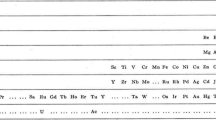Abstract
The Mendeleev periodic table of atoms is one of the most important principles in natural science. However, there is shortage of analog for molecules. Here we propose two periodic tables, one for diatomic molecules and one for triatomic molecules. The form of the molecular periodic tables is analogous to that of Mendeleev periodic table of atoms. In the table, molecules are classified and arranged by their group number G, which is the number of valence electrons, and the periodic number P, which represents the size of the molecules. The basic molecular properties, including bond length, binding energy, force constant, ionization potential, spin multiplicity, chemical reactivity, and bond angle, change periodically within the tables. The periodicities of diatomic and triatomic molecules are thus revealed. We also demonstrate that the periodicity originates from the shell-like electronic configurations of the molecules. The periodic tables not only contain free molecules, but also the “virtual” molecules present in polyatomic molecules. The periodic tables can be used to classify molecules, to predict unknown molecular properties, to understand the role of virtual molecules in polyatomic molecules, and to initiate new research fields, such as the periodicities of aromatic species, clusters, or nanoparticles. The tables should be of interest not only to scientists in a variety of disciplines, but also to undergraduates studying natural sciences.
Similar content being viewed by others
References
Clark CH. The periodic groups of non-hydride di-atoms. Trans Faraday Soc, 1935, 31: 1017–1036
Hefferlin R. Systematics of diatomic molecular transition moments: Encouraging progress—II. J Quant Spectrosc Radiat Transfer 1979, 16: 1101–1108
Hefferlin R, Campbell R. Periodic table for diatomic-molecules. Bull Am Phys Soc, 1978, 23: 143–143
Hefferlin R, Kuzner M. Systematics of ground-state potential minima between two main-group atoms or ions. J Chem Phys, 1981, 75: 1035–1036
Hefferlin R, Innis W. The differential coefficient (∂p/∂n)ne for properties of diatomic molecules and atoms. J Quant Spectrosc Radiat Transfer, 1983, 29: 97–112
Kong F. The periodicity of diatomic molecules. J Molec Struct, 1982, 90: 17–28
Carlson CM, Cavanaugh RJ, Hefferlin RA, Zhuvikin GV. Periodic systems of molecular states from the boson group dynamics of SO(3)×SU(2)s. J Chem Inf Comp Sci, 1996, 36: 396–398
Hefferlin R, Sepman A, Zhuvinkin G. Molecular multiplets of alkaline atoms. J Chem Inf Comput Sci, 1996, 36: 399–401
Kamal C, Banerjee A, Ghanty TK, Chakrabarti A. Interesting periodic variations in physical and chemical properties of homonuclear diatomic molecules. Int J Quant Chem, 2011, 112: 1097–1106
Sidgwick NV. The nature of the non-polar link. Trans Faraday Soc, 1923, 19: 469–475
Haas A. Periodic system of functional groups: Formalism only or heuristic principles. Pure Appl Chem, 1991, 63: 1577–1590
Peppernick KD, Gunaratne KD, Castleman AW. Superatom spectroscopy and the electronic state correlation between elements and isoelectronic molecular counterparts. Proc Natl Acad Sci USA, 2010, 107: 975–980
Lide DR. CRC Handbook of Chemistry and Physics: A Ready-reference Book of Chemical and Physical Data. Boca Raton, Florida: CRC Press, 1991
Walsh AD. The electronic orbitals, shapes, and spectra of polyatomic molecules. Part III. HAB and HAAH molecules. J Chem Soc, 1953, 2288
Author information
Authors and Affiliations
Corresponding author
Electronic supplementary material
Rights and permissions
About this article
Cite this article
Kong, F., Wu, W. Periodic tables of diatomic and triatomic molecules. Sci. China Chem. 55, 618–625 (2012). https://doi.org/10.1007/s11426-012-4495-z
Received:
Accepted:
Published:
Issue Date:
DOI: https://doi.org/10.1007/s11426-012-4495-z




